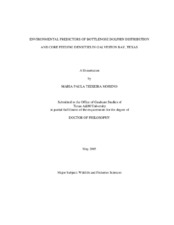| dc.description.abstract | Coastal dolphins are often exposed to habitat degradation and direct interactions with
humans. Major factors that influence dolphin distribution, critical for conservation
concerns, are still poorly understood even for the bottlenose dolphin, the best-studied
cetacean. To establish the environmental conditions that best predict occurrence of
bottlenose dolphins and high feeding densities in Galveston Bay, I conducted a total of
367 boat surveys in five locations of the estuary, totaling 3,814.77 km of search effort. I
counted groups of dolphins and measured surface water temperature, salinity, turbidity,
total number of boats, shrimp vessels, and number of seabirds. Using geospatial tools,
these data -- along with location, distance to the Gulf of Mexico and water depth -- were
analyzed on a 500- m resolution grid. Temporal factors at daily and seasonal scales were
also examined. Occurrence was modeled using a Generalized Additive Model and core
feeding densities (i.e., feeding densities above 2 SD of the mean) were modeled with a
Generalized Linear Model. A total of 1,802 dolphins in 262 groups were detected,
56.87% of which were feeding. I found that all factors except warm/cold seasons and
turbidity were useful to predict dolphin distribution, which was related non-linearly to
most predictors. Fewer variables were relevant in predicting core feeding densities.
These were, in decreasing order of relevance, distance to the Gulf of Mexico, surface
water temperature, depth, number of boats, and warm/cold seasons. Feeding was highly
clustered and the main core areas, less than approximately 3 km2 wide, were stable
across time of day and season. The majority of the occurrences (86.2%) and feeding
groups (94%) were situated in two bay locations - Galveston Ship Channel (GSC) and
Bolivar Roads (BRD) - that amounted to only one- fifth of the surveyed area. Compared
to conditions in GSC and BRD when no dolphins were sighted, feeding cores weredeeper and more seabirds were observed. This fine-scale study of bottlenose dolphin
distribution may contribute to a better understanding of habitat requirements for coastal
dolphins. It also may provide information needed to minimize potential negative impacts
to this population caused by human activities. | en |


